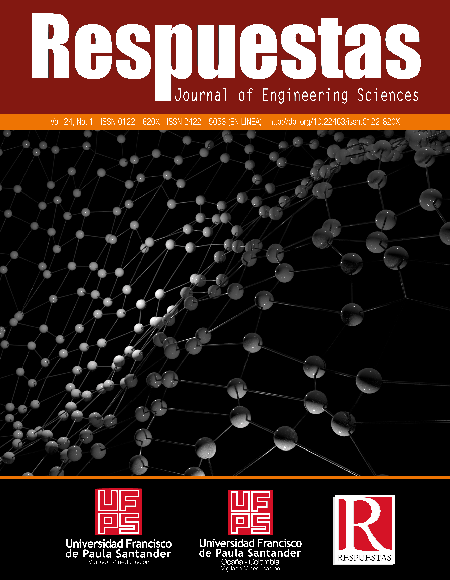Balance de líquidos - vapor para mezcla de metanol - benzen usando los modelos Peng Robinson y Van- Laar
Liquid balance - steam for methanol mixing - Benzen using the Peng Robinson and Van-Laar models
Contenido principal del artículo
El presente artículo está relacionado con el procedimiento para obtener las curvas de punto de rocío y de punto de burbuja en un equilibrio líquido - vapor (VLE) para una mezcla binaria con azeótropo de Metanol y Benceno a 45°C, utilizando la ecuación cúbica de Peng Robinson para calcular el coeficiente de fugacidad del gas i en la mezcla gaseosa, y el modelo de Van Laar para calcular el coeficiente de actividad del componente i en la mezcla líquida. Luego se compararon los datos teóricos con datos experimentales, posteriormente con el simulador comercial, el cual aplica el modelo de Wilson, se logró validar los datos experimentales, además de comparar los resultados con un simulador comercial.
Descargas
Detalles del artículo
N. Prieto Jiménez y G. González Silva, «Comparative Study of Equations of State for the Dew Curves Calculation in High Pressure Natural Gas Mixtures.», Rev. Logos Cienc. Tecnol., vol. 11, n.o 1, p. 13, 2018.
J.-H. Oh, K.-J. Han, D.-B. Won, y S.-J. Park, «Vapor–liquid equilibria for the ternary systems of methyl tert-butyl ether+ methanol+ benzene and methyl tert-butyl ether+ methanol+ toluene and constituent binary systems at 313.15 K», Fluid Phase Equilibria, vol. 209, n.o 2, pp. 215-228, 2003.
J.-H. Oh y S.-J. Park, «Vapor− liquid equilibria for the ternary systems of methyl tert-butyl ether+ methanol+ methylcyclohexane and methyl tert-butyl ether+ methanol+ n-heptane and constituent binary systems at 313.15 K», J. Chem. Eng. Data, vol. 50, n.o 5, pp. 1564-1569, 2005.
M. K. Balki y C. Sayin, «The effect of compression ratio on the performance, emissions and combustion of an SI (spark ignition) engine fueled with pure ethanol, methanol and unleaded gasoline», Energy, vol. 71, pp. 194–201, 2014.
L. Wen, C.-Y. Xin, y S.-C. Yang, «The effect of adding dimethyl carbonate (DMC) and ethanol to unleaded gasoline on exhaust emission», Appl. Energy, vol. 87, n.o 1, pp. 115–121, 2010.
M. Eyidogan, A. N. Ozsezen, M. Canakci, y A. Turkcan, «Impact of alcohol–gasoline fuel blends on the performance and combustion characteristics of an SI engine», Fuel, vol. 89,n.o 10, pp. 2713–2720, 2010.
P. Iodice, G. Langella, y A. Amoresano, «Ethanol in gasoline fuel blends: Effect on fuel consumption and engine out emissions of SI engines in cold operating conditions»,Appl. Therm. Eng., vol. 130, pp. 1081-1089, 2018.
M. B. Gramajo y A. M. Cases, «Liquid–Liquid Equilibria of the Methanol+ Hexane+ Methylcyclohexane+ Toluene Quaternary System at T= 303.15 K», J. Solut. Chem., vol. 44,n.o 2, pp. 171-180, 2015.
B. E. García-Flores, J. Águila-Hernández, F. García-Sánchez, y M. A. Aquino-Olivos, «(Liquid–liquid) equilibria for ternary and quaternary systems of representative compounds of gasoline+ methanol at 293.15 K: Experimental data and correlation», Fluid Phase Equilibria, vol. 348, pp. 60-69, 2013.
P. M. Mathias, Guidelines for the Analysis of Vapor–Liquid Equilibrium Data. ACS Publications, 2017.
F. Cai et al., «Isobaric vapor–liquid equilibrium for methanol+ dimethyl carbonate+ phosphoric-based ionic liquids», Fluid Phase Equilibria, vol. 352, pp. 47-53, 2013.
M. Yakovleva, E. Vorobyov, I. Pukinsky, I. Prikhodko, G. Kuranov, y N. Smirnova, «Liquid–liquid equilibria for ternary mixtures of 2, 2-dimethyl-1, 3-dioxolane-4-methanol with n-heptane, toluene, ethanol and water», Fluid Phase Equilibria,vol. 405, pp. 107-113, 2015.
B. E. Poling, J. M. Prausnitz, y J. O. Connell, The Properties of Gases and Liquids, 5.a ed. New York: McGraw- Hill Professional, 2000.







